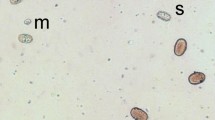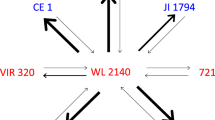Abstract
Analyses of populations ofRaphanus growing in the central part of California, from the Sierra Nevada foothills to the Pacific coast, show that pureR. raphanistrum can be found only in the Central Valley, while over the remainder of the area populations of the so-called “wild” (weedy)R. sativus occur. More detailed morphological studies of a number of populations in this area have revealed that the populations of “wild”R. sativus originated by hybridization of the cultivated forms of this species (the radish) with another introduced species, already a weed,R. raphanistrum. The composition of each hybrid population with respect to the proportion of characters of the one or the other species depends upon the habitat it occupies and its geographic location. Populations in inland areas display a high proportion ofR. raphanistrum characters, while in those near the coastR. sativus characters predominate.
Artificial hybrids betweenR. raphanistrum and a cultivated form ofR. sativus exhibited about 50% pollen fertility and were heterozygous for a reciprocal translocation. Examination of “wild” populations ofR. sativus revealed that plants heterozygous for a reciprocal translocation are present in varying proportions. Experimental evidence is produced to show that this translocation is identical with that separatingraphanistrum from cultivated forms ofsativus. Thus a cytological proof of the introgression is added to the morphological evidence. Introgression ofraphanistrum characters appears to have been a major factor in converting the erstwhile crop plant,R. sativus, into a highly successful weed in California.
Similar content being viewed by others
References
Abrams, L. 1944. Illustrated Flora of the Pacific States. vol. II. Buckwheats to Kramerias. Stanford University Press, Stanford.
Anderson, E. 1949. Introgressive Hybridization. John Wiley and Sons. New York, N.Y.
Anderson, E. 1953. Introgressive hybridization.Biol. Revs. 28: 280–350.
Anderson, E. 1954. An analysis of introgression in a population of stemless white violets.Ann. Mo. Bot. Gard. 41: 263–269.
Anderson, J. P. 1959. Flora of Alaska and adjacent parts of Canada. Iowa State University Press, Ames. Iowa.
Baker, H. G. 1962. Weeds—native and introduced.Jour. Calif. Hort. Soc. 23: 97–104.
Baker, H. G. 1965. Characteristics and modes of origin of weeds. pp. 147–172. inH. G. Baker &G. L. Stebbins (editors), The Genetics of Colonizing Species. Academic Press, New York.
De Candolle, A. 1883. Origin of Cultivated Plants. D. Appleton and Co., New York.
Conyer, A. D. &L. M. Fairchild 1953. A quick-freeze method for making smear slides permanent.Stain Technology 28: 281–283.
Darlington, C. D. &L. F. La Cour, 1950. The Handling of Chromosomes. G. Allen and Unwin, London.
Darlington, C. D. &A. P. Wylie, 1955. Chromosome Atlas of Flowering Plants. G. Allen & Unwin, London.
Davis, R. J. 1952. Flora of Idaho. W. M. C. Brown Co., Dubuque, Iowa.
Frost, H. B. 1923. Heterosis and dominance of size factors inRaphanus.Genetics 8: 116–153.
Gleason, H. A. 1952. The New Britton and Brown Illustrated Flora of the North-eastern United States and adjacent Canada. Vol. 1. Lancaster Press. Lancaster, Pennsylvania.
Hall, H. M. &Carlotta C. Hall 1912. A Yosemite Flora. Paul Elder and Co., San Francisco.
Hegi, G. 1935. Illustrierte Flora von Mittel-Europa. Band IV, Haffte I. J. F. Lehmann's Verlag, München.
Heiser, C. B. Jr. 1947. Variability and hybridization in sunflower species.Helianthus annuus andH. bolanderi in California.Ph. D. thesis. University of California.
Howell, J. T. 1949. Marin Flora. University of California Press, Berkeley and Los Angeles.
Jepson, W. L. 1909–36. A Flora of California. Students Cooperative Society, University of California, Berkeley, California.
Jones, G. N. 1945. Flora of Illinois. Notre Dame University Press, South Bend, Indiana.
Karpechenko, G. D. 1924. Hybrids ofRaphanus sativus L.×Brassica oleracea L.Jour. Genetics 14: 375–396.
Karpechenko, G. D. 1928. Polyploid hybrids ofRaphanus sativus L.×Brassica oleracea L.Z. Vererbungslehre 48: 1–85.
Kobabe, G. 1959. Naturliche Einkreuzung von Heterich (Raphanus raphanistrum L.) in Radies (Raphanus sativus L. var.Radicula D. C.) und das Verhalten von Knollen Form und Farbe in den nachfolgenden F und R Generationen.Zeitschr. für Pflanzenzuchtung 42: 1–10.
Munz, P. A. 1959. A California Flora (in collaboration withD. D. Keck). University of California Press, Berkeley and Los Angeles.
Robbins, W. W. 1917. Botany of Crop Plants. P. Blakiston's Sons and Co., Philadelphia.
Robbins, W. W. 1940. Alien plants growing without cultivation in California.University of California Agricultural Experiment Station Bulletin 637. University of California, Berkeley.
Robbins, W. W. &F. Ramaley 1933. Plants Useful to Man. P. Blakiston's Sons & Co., Philadelphia.
Small, J. K. 1933. Manual of the Southeastern Flora. Publ. by the author, New York.
Trouard-Riolle, Y. 1914. Recherches morphologiques et biologiques sur les radis cultivés.Ann. Sci. Agron. Franç. et Etrang. 31: 295–322, 346–550.
Author information
Authors and Affiliations
Rights and permissions
About this article
Cite this article
Panetsos, C.A., Baker, H.G. The origin of variation in “wild”Raphanus sativus (Cruciferae) in California. Genetica 38, 243–274 (1967). https://doi.org/10.1007/BF01507462
Received:
Issue Date:
DOI: https://doi.org/10.1007/BF01507462




